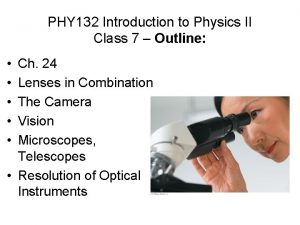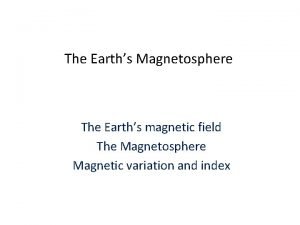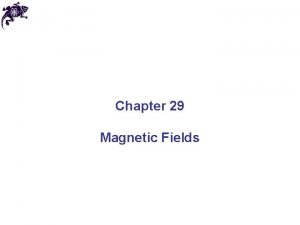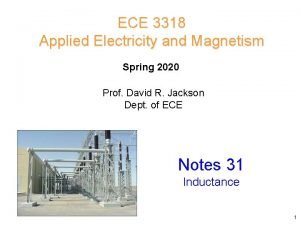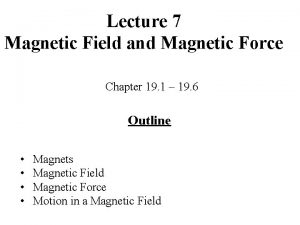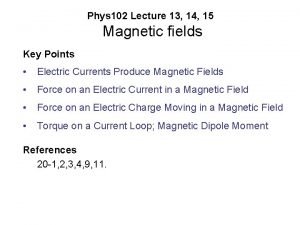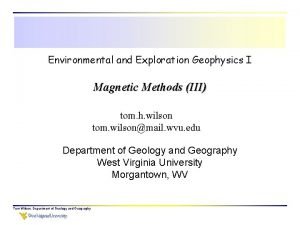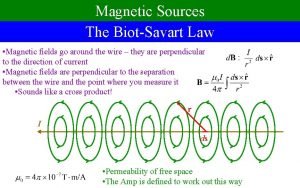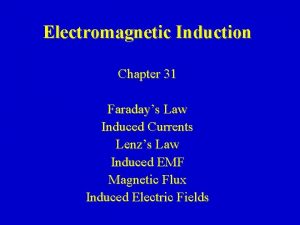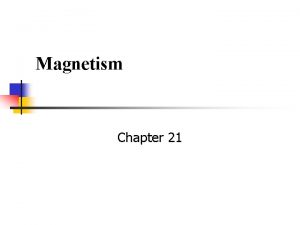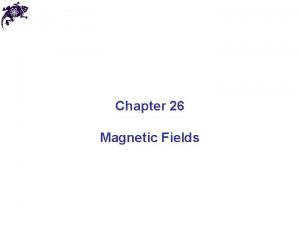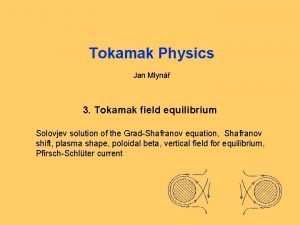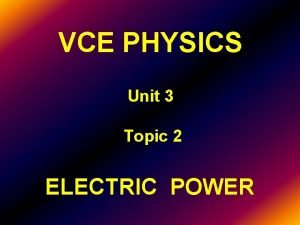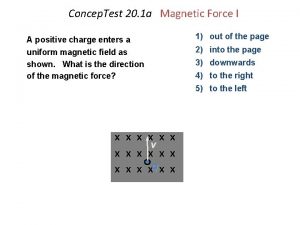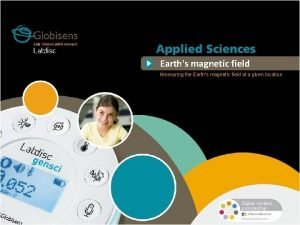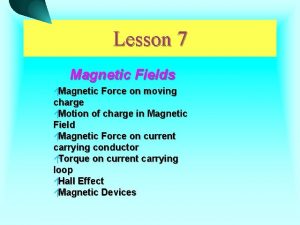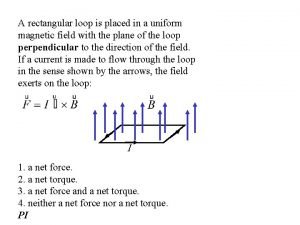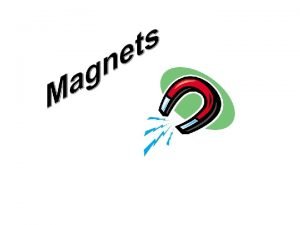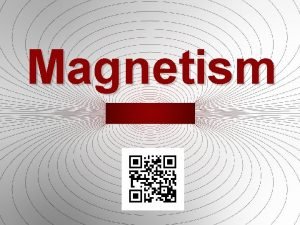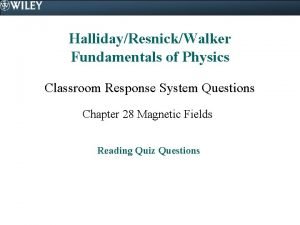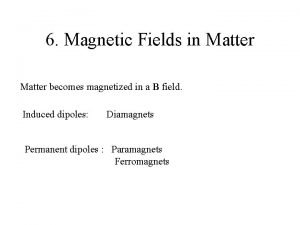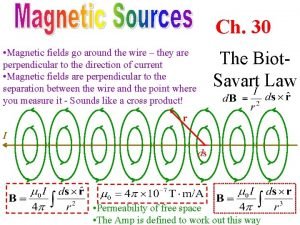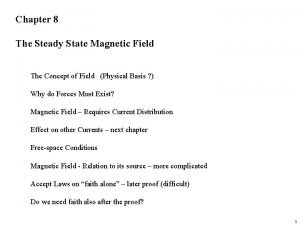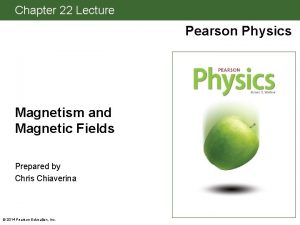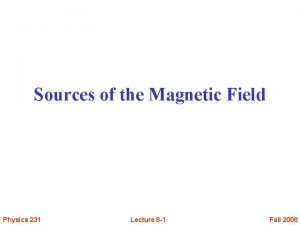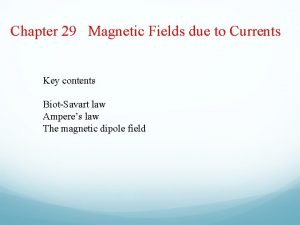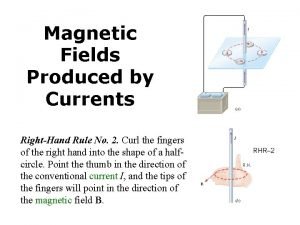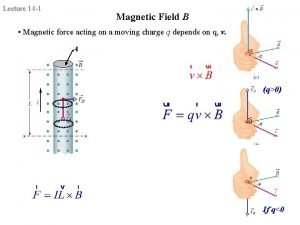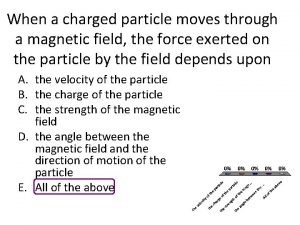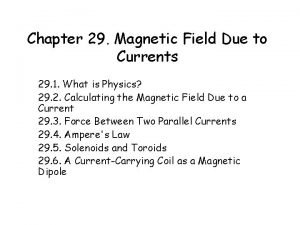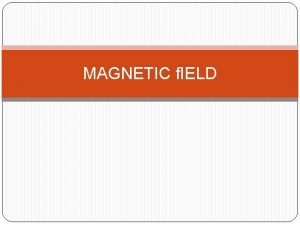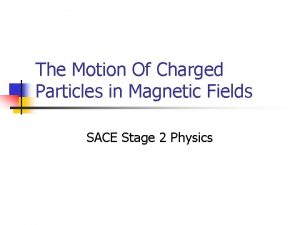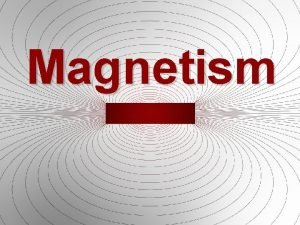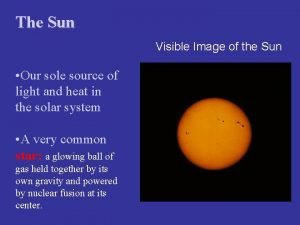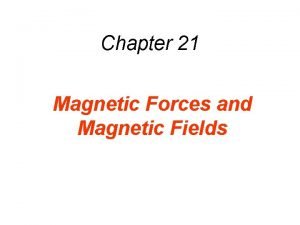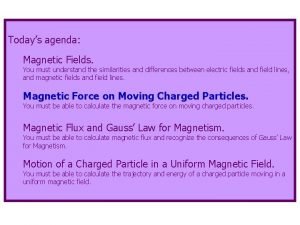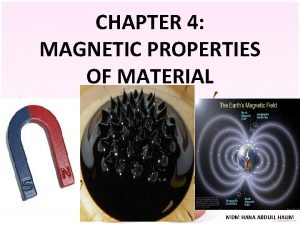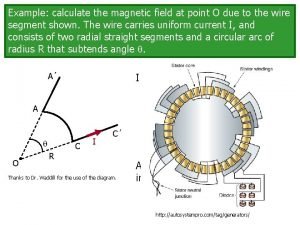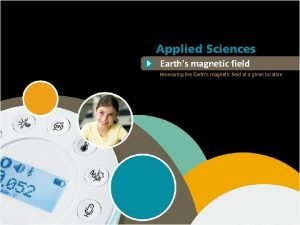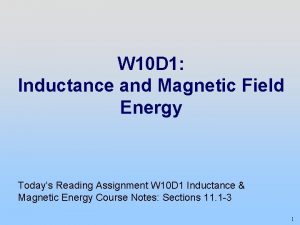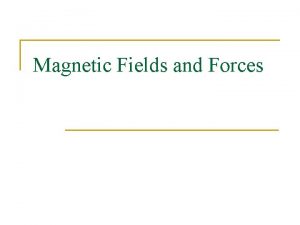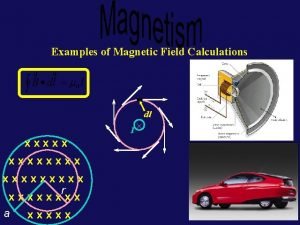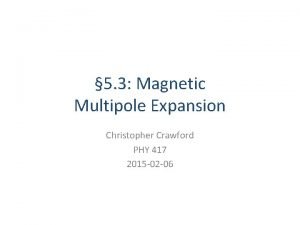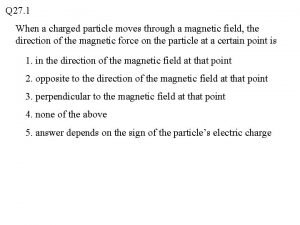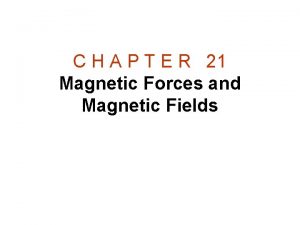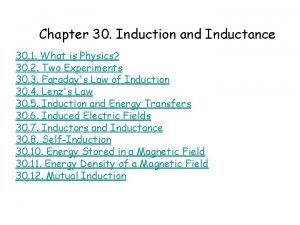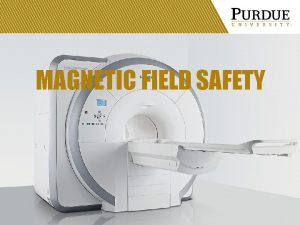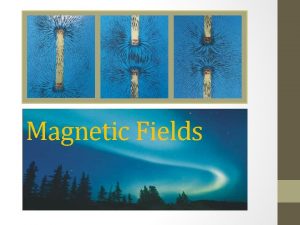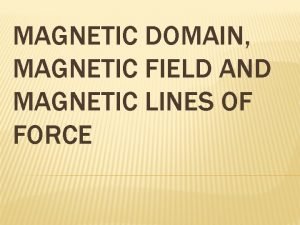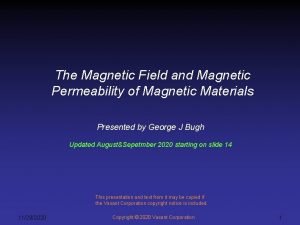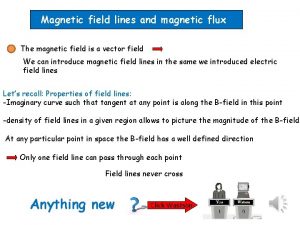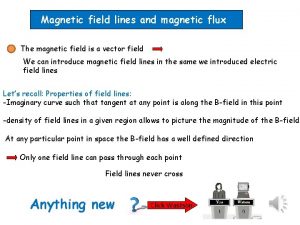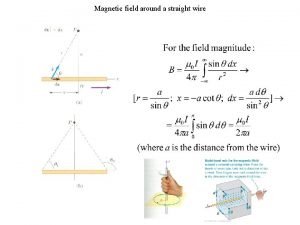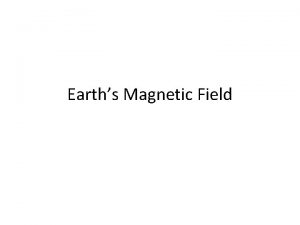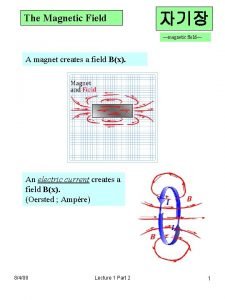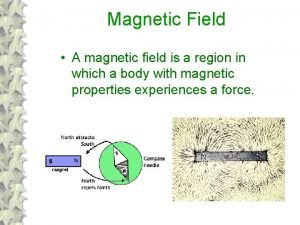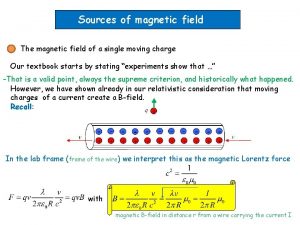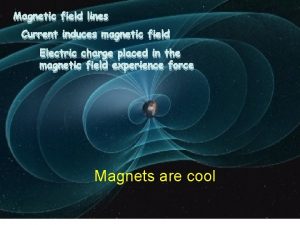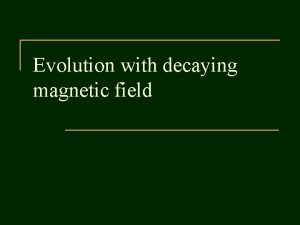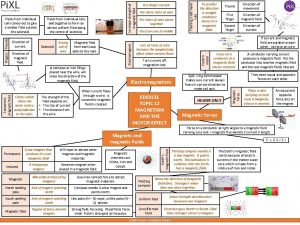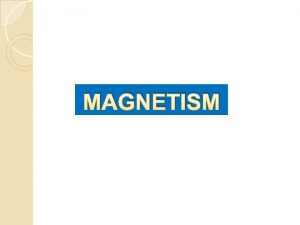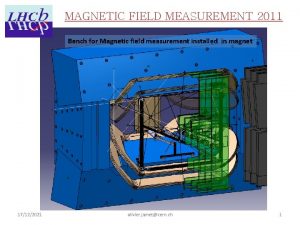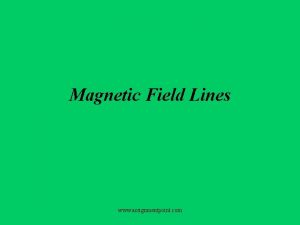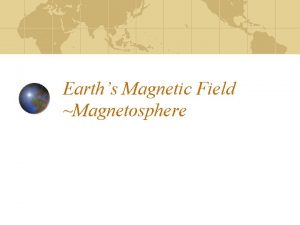PHY 102 Lecture 6 6 1 Magnetic Field





























































- Slides: 61

PHY 102: Lecture 6 • • 6. 1 Magnetic Field 6. 2 Magnetic Force on Moving Charges 6. 3 Magnetic Force on Currents 6. 4 Magnetic Field Produced by Current

PHY 102: Lecture 6 Magnetic Force Magnetic Fields 6. 1 Magnetic Field

Basics of This Chapter • Charge moving in a magnetic field feels a force • Moving charge creates a magnetic field

Magnetic Field Into and Out of Page

Magnetic Poles • North magnetic pole – The end of the needle that points north • South magnetic pole – The opposite end • No one has been able to separate magnetic poles • Electric charges can be separated

Magnetic Force • Direction of the magnetic force – Like poles repel each other – Unlike poles attract each other

Magnetic Field • A magnetic field is created at all points in space surrounding a magnet • The magnetic field at each point is a vector. It has both a magnitude called the magnetic field strength B, and a direction • The magnetic field exerts forces on magnetic poles. The force on a north magnetic pole is parallel to B; the force on a south magnetic pole is opposite to B • Magnetic forces cause a compass needle to become aligned parallel to a magnetic field, with the north pole of the compass showing the direction of the magnetic field at that point

Magnetic Field Lines • Magnetic field lines – To visualize the electric field, we introduced electric field lines – It is possible to draw magnetic field lines – The lines originate from north pole, and end on the south pole – They do not end in midspace – The strength of the field is proportional to the number of lines per unit area that passes through a surface oriented perpendicular to the lines

Magnetic Pole Force Directions - 1

Magnetic Pole Force Directions - 2 • At any location in the vicinity of a magnet, the north pole of a small compass needle points in the direction of the magnetic field at that location

Magnetic Field Lines

Earth’s North Magnetic Pole • The compass and field lines point to the earth’s north magnetic pole • Therefore, the earth’s north magnetic pole is actually a south pole

PHY 102: Lecture 6 Magnetic Force Magnetic Fields 6. 2 Magnetic Force on Moving Charge

Magnetic Field Force on Moving Charge • Two conditions must be met for a charge to experience a magnetic force when placed in a magnetic field – The charge must be moving – The velocity of the moving charge must have a component that is perpendicular to the direction of the magnetic field

No Force – Velocity Parallel to Magnetic Field

Max Force – Velocity Perpendicular to Magnetic Field

Some Force – Velocity at Angle to Magnetic Field

Direction of Magnetic Force Right-Hand Rule No. 1 • Extend the right hand so the fingers point along the direction of the magnetic field B • The thumb points along the velocity v of the charge • The palm of the hand then faces in the direction of the magnetic force F that acts on a positive charge • If the moving charge is negative, the direction of the magnetic force is opposite to that predicted by RHR-1

Illustration of Right-Hand Rule No. 1

Definition of Magnetic Field • The magnitude B of the magnetic field at any point in space is defined as • • F is the magnitude of magnetic force on a test charge |q 0| is the magnitude of the test charge v is the magnitude of the charge’s velocity v makes an angle (0 <= 1800) with the direction of the magnetic field • The magnetic field B is a vector, and its direction can be determined by using a small compass needle • SI Unit of Magnetic Field = 1 tesla (T)

Problem 1 - 1 • A proton in a particle accelerator has a speed of 5. 0 x 106 m/s • The proton encounters a magnetic field whose magnitude is 0. 40 T • Direction of the field makes and angle of q = 30. 00 with respect to the protons velocity • (a) Find the magnitude and direction of the magnetic force on the proton • (b) The acceleration of the proton

Problem 1 - 2 ü (a) Positive charge on proton is 1. 60 x 10 -19 C ü Magnitude of force is F = |q 0|v. B sinq ü The direction of the magnetic force is given by RHR-1 and is directed upward

Problem 1 - 3 ü (b) Acceleration if from Newton’s second law ü a = F/m = 1. 6 x 10 -13 / 9. 11 x 10 -31 = 1. 8 x 1017 m/s 2

Compare Particle Motion in Electric and Magnetic Field • Positive charge moving between the plates of a parallel plate capacitor • Initially, the charge is moving perpendicular to the electric field • Direction of the electric force is in the same direction as the electric field • Particle is deflected sideways

Compare Particle Motion in Electric and Magnetic Field • Initially, positive charge is moving at right angles to a magnetic field • When the charge enters the field it is deflected upwards by magnetic force • As charge moves upward, the direction of the magnetic force changes • Force always remains perpendicular to the magnetic field and velocity • Charge moves in circle

Velocity Selector • Force of the electric field on particle is q. E in downward direction • Force of the magnetic field on the moving particle is qv. B in the upward direction • The forces are balanced when • q. E = qv. B • v = E/B • This is the velocity of the particle that will pass straight through the velocity filter from one end to the other

Work Done on a Charged Particle Moving Through Magnetic Field • The force is perpendicular to the direction of motion • Therefore, the work done by the magnetic field is zero

Circular Trajectory - 1 • Velocity of positively charged particle is perpendicular to a constant magnetic field • The magnetic force moves the particle in a circular path • At point 1, the magnetic force F points upward • This force causes the parth to bend upward

Circular Trajectory - 2 • At point 2, the magnetic force is directed to the left • The magnetic force always remains perpendicular to the velocity • Force is directed toward the center of the circular path

Circular Trajectory - 3 • Centripetal force equals magnetic force

Problem 2 - 1 • Proton is released from rest at point A next to positive plate of parallel plate capacitor • Proton accelerates towards the negative plate • Proton leaves capacitor at point B through a small hole • Electric potential of positive plate is 2100 V greater than the negative plate ü VA – VB = 2100 V

Problem 2 - 2 • Outside the capacitor, the proton travels at a constant velocity until it enters a region of constant magnetic field • Field is directed out of the page ü B = 0. 10 T • Velocity is perpendicular to the magnetic field

Problem 2 - 3 • (a) Find the speed v. B of the proton when it leaves the negative plate of the capacitor • (b) Find the radius r of the circular path on which the proton moves in a magnetic field

Problem 2 - 4 • (a) • Electric force is conservative • Energy is conserved while in capacitor

Problem 2 - 5 • (b) The radius of curvature of the circular path in the magnetic field is

Problem 3 - 1 • Bubble-chamber tracks resulting from event at point A • A gamma ray traveling from the left spontaneously transforms into two charged particles • No track from gamma ray • Particles move away from point A producing two spiral tracks • A third charged particle is knocked out of a hydrogen atom and moves forward producing the long track with the slight upward curvature

Problem 3 - 2 • Each particle has the same mass and a charge of the same magnitude • A uniform magnetic field is directed out of the page • Based on RHR-1 and formula for radius of curved track in magnetic field, we know: ü Particles 1 and 3 are – ü Particle 2 is + ü Particles 1 and 2 are losing energy to hydrogen collisions because tracks spiral inward ü Particle 3 has greatest speed

Mass Spectrometer - 1

Mass Spectrometer - 2 • Conservation of energy in electric field • Radius of curvature in magnetic field

Mass Spectrometer Output

Dr. Molof Thesis Rb 85, 87 Special Spectrometer Scan

PHY 102: Lecture 6 Magnetic Force Magnetic Fields 6. 3 Magnetic Force on Currents

Force on Current in Magnetic Field

Problem 4 - 2 Rail Gun • • Two conducting rails are 1. 6 m apart Rails are parallel to the ground at the same height A 0. 20 -kg aluminum rod is lying on top of the rails A 0. 050 -T magnetic field points upward The field is perpendicular to the ground There is a current in the rod The coefficient of static between rod and rails is s = 0. 45

Problem 4 - 2 Rail Gun • How much current is needed to make the rod begin to move? • In what direction will it move?

Problem 4 - 3 Rail Gun • • Friction force = f = s. N = smg f = 0. 45 x 0. 20 x 9. 8 = 0. 882 N Magnetic force = ILB = I(1. 6)(0. 050) Magnetic force = (0. 08)I N 0. 882 = 0. 08 I I = 0. 882 / 0. 08 = 11. 0 A If current is positive RHR-1 give motion to left, negative to the right

PHY 102: Lecture 6 Magnetic Force Magnetic Fields 6. 4 Magnetic Field Produced by Current

Right Hand Rule No. 2 • Curl the fingers of the right hand into the shape of a half-circle • Point the thumb in the direction of the conventional current I • The tips of the fingers will point in the direction of the magnetic field B

Magnetic Field Long Straight Wire 0 = 4 x 10 -7 Tm/A This is permeability of free space r is distance from wire

Problem 5 - 1 • Long straight wire carries current of 3. 0 A • Particle charge of +6. 5 x 10 -6 C • Particle moving parallel to wire at distance of 0. 050 m • Particle speed is 280 m/s • Find magnitude and direction of the magnetic force exerted on the charged particle by the current in the wire.

Problem 5 - 2 • Magnetic field produced by wire • Force on charge F= • Direction magnetic force is radially inward toward wire (RHR-1)

Problem 6 - 1 • • Two long, parallel, straight wires Wires separated by 0. 065 m Current is I 1 = 15 A and I 2 = 7. 0 A Find the magnitude and direction of force that magnetic field of wire 1 applies to a 1. 5 m section of wire 2

Problem 6 - 2 • Magnetic force on part of wire 2 • Magnetic field produced by wire 1 • Combined

Problem 6 - 3 • Using RHR-1 the force on wire 2 is away from wire 1 • Using Newton’s Third Law, the force on wire 1 is away from wire 2 • If the current in wire 2 is reversed, the direction of the forces is reversed

Magnetic Field Loop of Wire • Field at center of loop • N is number of coils in loop • R is the radius of the loop

Loop of Wire acts like Bar Magnet • Current-carrying loop acts like a bar magnet

Two Loop of Wire acts like Repel/Attract Bar Magnets • When the currents are in the same direction the loops attract • When the currents are in opposite directions the loops repel • Used RHR-1

Magnetic Field Long Solenoid • Field inside of solenoid • N is number of coils in loop

Ampere’s Law • Constant magnetic field Dl is a small segment of length along a closed path of arbitrary shape round the current • B|| is the component of the magnetic field parallel to Dl, • I is the net current passing through the surface bounded by the path 0 is the permeability of free space • Symbol S indicates that the sum of all terms must be taken around the closed path

Problem 7 - 1 • Use Ampere’s law to obtain the magnetic field produced by the current in an infinitely long, straight wire • Along the circular path the magnetic field is parallel to Dl and has constant magnitude

Problem 7 - 2
 Magnetic field and magnetic force
Magnetic field and magnetic force Magnetic moment and magnetic field relation
Magnetic moment and magnetic field relation Permeability unit
Permeability unit Nearsightedness physics
Nearsightedness physics Q factor of capacitor
Q factor of capacitor Magnetic field
Magnetic field Electric field and magnetic field difference
Electric field and magnetic field difference Remanent magnetization
Remanent magnetization 01:640:244 lecture notes - lecture 15: plat, idah, farad
01:640:244 lecture notes - lecture 15: plat, idah, farad Dot and cross in magnetic field
Dot and cross in magnetic field Magnetic field equation
Magnetic field equation Potential energy magnetic field
Potential energy magnetic field Hand rule for magnetic field
Hand rule for magnetic field Magnetic force si unit
Magnetic force si unit Visualizing magnetic field
Visualizing magnetic field Magnetic field intensity
Magnetic field intensity Magnetic field of a finite wire
Magnetic field of a finite wire Faraday's law of electromagnetic induction
Faraday's law of electromagnetic induction Pancake coil magnetic field
Pancake coil magnetic field Magnetic field strength
Magnetic field strength Magnetic torque
Magnetic torque Magnetic field formula
Magnetic field formula Right hand palm rule magnetic field
Right hand palm rule magnetic field When is magnetic field zero
When is magnetic field zero Visualizing magnetic field
Visualizing magnetic field Earth magnetic field value
Earth magnetic field value Work done by magnetic field
Work done by magnetic field A conducting loop is halfway into a magnetic field
A conducting loop is halfway into a magnetic field Magnetic field lines always cross.
Magnetic field lines always cross. Magnetic field lines that curve away from each other show
Magnetic field lines that curve away from each other show Physics classroom magnetic field
Physics classroom magnetic field Magnetic field in matter
Magnetic field in matter Magnetic field drift
Magnetic field drift Magnetic field of a finite wire
Magnetic field of a finite wire Steady magnetic field meaning
Steady magnetic field meaning Visualizing magnetic field
Visualizing magnetic field Magnetic field unit
Magnetic field unit Magnetic field outside a wire
Magnetic field outside a wire Magnetic field
Magnetic field Magnetostatic field
Magnetostatic field Magnetic
Magnetic Force of magnetic field
Force of magnetic field Net magnetic field
Net magnetic field Magnetic field
Magnetic field Kinetic energy magnetic field
Kinetic energy magnetic field Horseshoe magnet magnetic field
Horseshoe magnet magnetic field Sunspots magnetic field
Sunspots magnetic field Does magnetic field exerts force on a static charge
Does magnetic field exerts force on a static charge 21lwuy8i6hw -site:youtube.com
21lwuy8i6hw -site:youtube.com Magnetic field strength h
Magnetic field strength h Find the magnetic field at point o
Find the magnetic field at point o Earth magnetic field value
Earth magnetic field value Toroid magnetic field
Toroid magnetic field Magnetic force
Magnetic force Xxxxxxxx r
Xxxxxxxx r Sharks use magnetic field to navigate
Sharks use magnetic field to navigate Arah momen dipol
Arah momen dipol Multipole expansion griffiths
Multipole expansion griffiths When a charged particle moves in a region of magnetic field
When a charged particle moves in a region of magnetic field Magnetic force unit
Magnetic force unit Induced current
Induced current Right hand rule 3
Right hand rule 3



